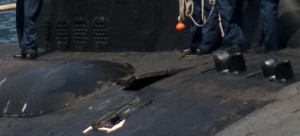 The indefatigable Peter Frost from the Newport News Daily Press sunk his teeth into the Virginia Class sub-skin failures (which we have been covering here, here and here), leading to a nice article that, earlier this week, bounced the ball down-field a good bit. Sharing a story with the grand-old-man of naval observation, Norman Polmar, was a real rush.
The indefatigable Peter Frost from the Newport News Daily Press sunk his teeth into the Virginia Class sub-skin failures (which we have been covering here, here and here), leading to a nice article that, earlier this week, bounced the ball down-field a good bit. Sharing a story with the grand-old-man of naval observation, Norman Polmar, was a real rush.
Meanwhile, Adam Weinstein, the Copy Editor over at Mother Jones, caught up with me between Fleet Week planning gigs, where we had a good chat about the Virginia Class woes. It lead to this fun story:
How could one of the world’s most advanced pieces of military machinery be laid low by something so basic? Officers and contractors may have been cutting corners when the subs were built, says Craig Hooper, a San Francisco-based security strategist who’s been tracking the Virginia-class woes on his blog Next Navy. “The demand to build this submarine in a fast, cost-effective way led them to skip some steps that should have been in the process,” he says. “They’ve got this beautiful, fantastic vessel, and they just covered it in a Wal-Mart tarp.”
And:
The Navy has been slow to say much about the problem. When it has, it’s contradicted itself. Sailors who work in the office of the Virginia program initially told media that the hull-splitting issue came to light in 2006; they later claimed that it first popped up in 2007, immediately after a brand-new sub was delivered with its skin peeling. The Navy also asserts that only three subs—the USS Virginia, Texas, and North Carolina—have succumbed to hull decay. But Hooper brought the service’s attention to its own public affairs photos, which show damage on the USS Hawaii as well. In response, the Navy said that the peeling tiles were part of normal wear and tear. Hooper says the photos of the Hawaii, which was peeling after a routine 10-day voyage, prove otherwise. “The
program office is saying this happens over years. It doesn’t.”
Asked for comment, Northrop and General Dynamics—two of the military’s largest vendors—both referred questions to the Navy.
Military analyst Hooper doubts the Navy can be trusted to face up to the seriousness of the problem. “If the Virginia-class program office cannot muster the cojones to even recognize a problem that is staring ’em in the face, how in the heck is the rest of Big Navy going to muster the will to get the problem solved?” he asks. “This lack of intestinal fortitude will, in a shooting war, get our sailors killed.”
Good to see larger media taking an interest in this ugly case of systems engineering failure. Why spend 2.7 billion dollars only to coat the world’s quietest sub with a maritime noisemaker?
